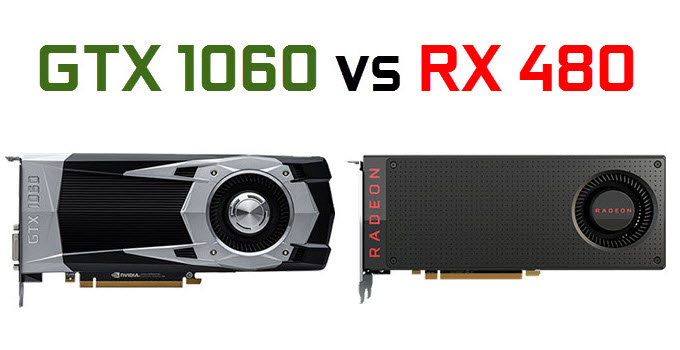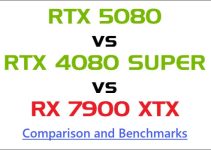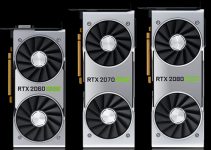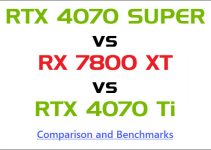GeForce GTX 1060 and Radeon RX 480 are powerful graphics cards from Nvidia and AMD respectively. GeForce GTX 1060 is a higher mid-range graphics card in the GeForce GTX 10 series lineup whereas Radeon RX 480 is on the top of the Polaris series graphics cards from AMD. Both these graphics cards are very powerful and compete with each other in the same performance as well as the price segment.

Must Read:
GeForce GTX 1060 vs Radeon RX 480
Here is a comparison of GeForce GTX 1060 and Radeon RX 480 graphics cards based on their specifications and gaming performance.
GPU Architecture
GeForce GTX 1060 is based on the latest Pascal GPU architecture from Nvidia and comes with 1152 and 1280 CUDA Cores for 3GB and 6GB variants respectively whereas Radeon RX 480 is built on the Polaris GPU architecture from AMD and comes with 2304 Stream Processors or Pixel Pipelines. GeForce GTX 1060 is built on the 16nm fabrication process while Radeon RX 480 is built on the 14nm fabrication process. It must be noted that Nvidia CUDA Cores and AMD Stream Processors work on different GPU architectures and they cannot be equated just based on their numbers.
Must Read: CUDA Cores vs Stream Processors
Memory
GeForce GTX 1060 comes in two memory variants, one with 3GB GDDR5 memory and another one with 6GB GDDR5 video memory. The 3GB version is slightly less powerful because it also has 128 CUDA Cores less compared to the 6GB variant. The memory interface for both variants is 192-bit only.
On the other hand, Radeon RX 480 comes with 4GB and 8GB GDDR5 memory versions. Unlike GTX 1060, the stream processors in RX 480 for different memory variants remain the same at 2304. The memory interface for RX 480 is 256-bit and thus it has considerably higher memory bandwidth compared to GTX 1060.
Features
Both GTX 1060 and RX 480 support the latest APIs that include DirectX 12, OpenGL 4.5, and Vulkan. In terms of features, Radeon RX 480 does have a greater advantage over GTX 1060 because RX 480 supports multi-GPU setup (CrossFire) and is VR Ready (AMD LiquidVR technology) which GTX 1060 lacks.
Both these graphics cards support their own variable refresh rate technologies to prevent screen tearing and stuttering in games. GTX 1060 supports G-Sync and Radeon RX 480 has FreeSync.
Gaming Performance
Both these graphics cards can run latest games on high and ultra settings on 1080p and 1440p resolution. For 1440p resolution, you may have to lower some of the graphics settings in the games. The 3GB version of GTX 1060 and 4GB variant of RX 480 are more suitable for 1080p gaming only while the higher memory variants i.e. 6GB GTX 1060 and 8GB RX 480 can allow you to play games on 1440p resolution also.
The gaming performance of both these high-end graphics cards is very close to each other. At 1080p gaming, in older APIs like DX11, GTX 1060 has better performance while in DX12 and Vulkan, RX 480 is better most of the time. In terms of overall performance, we can say that there is a tie between GTX 1060 and RX 480 because in some games GTX 1060 is faster, and in some RX 480 has better performance. It must be noted that GTX 1060 was generally faster in the beginning but with the latest AMD Driver update, Radeon RX 480 now leads in performance over GTX 1060.
Some Benchmarks for GTX 1060 and Radeon RX 480
| Very High / Ultra Settings at 1080p | GeForce GTX 1060 6GB | Radeon RX 480 8GB |
| Dishonored 2 @ DX11 | 29 FPS | 29 FPS |
| Doom (2016) @ Vulkan | 39 FPS | 42 FPS |
| Sniper Elite 4 @ DX12 | 29 FPS | 34 FPS |
| Resident Evil 7 @ DX11 | 26 FPS | 27 FPS |
Power Consumption
This is one area where GTX 1060 wins hands down. GeForce GTX 1060 consumes considerably lesser power compared to Radeon RX 480. The maximum power consumption of GTX 1060 is at 120W while that of Radeon RX 480 is from 150W to 165W.
Almost all the GTX 1060 graphics cards from different graphics cards manufacturers require only a 6-pin PCI Express power connector but Radeon RX 480 requires an 8-pin PCI-E power connector from the PSU. Also, Radeon RX 480 runs a bit hotter than GTX 1060.
Price
In terms of pricing Radeon RX 480 wins because it is a bit cheaper than the GeForce GTX 1060. You can check the prices of both these graphics cards from the links given below.
GTX 1060 vs RX 480 Specifications
| Specifications | GeForce GTX 1060 | Radeon RX 480 |
| CUDA Cores / Stream Processors | 1152 (3GB) / 1280 (6GB) | 2304 |
| GPU Architecture | Pascal | Polaris |
| Memory Size | 3GB / 6GB GDDR5 | 4GB / 8GB GDDR5 |
| Memory Interface | 192-bit | 256-bit |
| Memory Bandwidth | 192 GB/s | 224GB/s or higher |
| Bus Interface | PCI Express 3.0 | PCI Express 3.0 |
| DirectX | 12 | 12 |
| OpenGL | 4.5 | 4.5 |
| Vulkan API | Yes | Yes |
| SLI/ CrossFire | No | Yes, CrossFire |
| VR Ready | No | Yes |
| G-Sync / FreeSync | G-Sync | FreeSync |
| Power Consumption | 120W | 150W – 165W |
| Recommended PSU | 400W | 450W – 500W |
See also: GTX 1050 vs RX 460 Comparison
Final Verdict
Both GTX 1060 and RX 480 are solid graphics cards for gaming on ultra settings at 1080p and 1440p (with some lower graphics settings). Both of them are very close to each other both in terms of performance and pricing. The main advantage of GTX 1060 is that it consumes lesser power but RX 480 is more future-proof and comes with higher memory capacity & bandwidth, and also it is a bit cheaper. So my pick here would be the Radeon RX 480 with 8GB GDDR5 memory. If you still have any queries or doubts then feel free to ask me by leaving a comment below.
My Pick: Radeon RX 480 8GB
(*This post may contain affiliate links, which means I may receive a small commission if you choose to purchase through the links I provide (at no extra cost to you). Thank you for supporting the work I put into this site!)



What about the invida 970 vs the 1060 or any other, what is the best graphics card for a i7 2700 with 32 gb ram.
Go with the GTX 1060 or GTX 1650 SUPER.